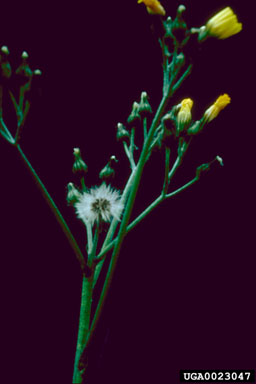meadow hawkweed complex
 Background:
The meadow
hawkweed complex consists of three closely related species: meadow
hawkweed, king devil hawkweed, and yellow devil hawkweed (3). It
is a perennial weed that came to the United States from Europe. (1)
Background:
The meadow
hawkweed complex consists of three closely related species: meadow
hawkweed, king devil hawkweed, and yellow devil hawkweed (3). It
is a perennial weed that came to the United States from Europe. (1)
Roots: Shallow fibrous roots. (1,3,4)
Leaves: The leaves are hairy, spatula shaped, and mostly
basal. They can be up to six inches long. The leaf shape
is generally longer than it is wide. The leaves vary in color from pale
green to red-green. When broken apart, the leaves exclude a milky
juice. (1-5)
Stems: The stem is tall and slender.
It is
bristly and hairy. It can reach a height of about 3 ft. It
often
contains two small leaves near the base. The stem branches off at
the
top into a flower cluster. When broken apart, the stem excludes a
milky
juice. (1-5)
Flower: The flowers have yellow heads in
a flat topped cluster on hairy glandular pedicals. They appear in
late May or June. The bracts under the flower heads have stiff
blackish hairs. (1-5)
Reproduction: The meadow
hawkweed
complex is able to reproduce without fertilization by stolons and
rhizomes.
It is a perennial that also reproduces sexually, producing vast amounts
of
seeds. (2,3)
Environments Favorable to Infestation: It tends to
grow in places where there isn't constant grazing such as meadows,
roadsides, pastures, lawns, and fields. (3,5)
Impacts: It can out compete many plants in fields,
pastures, range lands, and most of our native plant species.
There are no benefits, but some people think it looks pretty.
(2)
Methods of Control/How to Prevent Spread: Herbicides
and grazing are the main ways used to control it. There are
currently no known biological control agents. Fertilizer (NPK)
will work if there is already a large amount of native plants in the
area. The fertilizer will make the native plants outcompete the
meadow hawkweed complex. (2,4,5)
Links:
- http://www.co.gem.id.us/weed/noxious/meadow_hawkweed.htm
- http://plantsdatabase.com/go/31767
- http://www.insectimages.org/browse/autthumb.cfm?aut=2332&start=1
- http://www.oneplan.org/Crop/noxWeeds/nxWeed18.htm
- http://www.montana.edu/wwwpb/pubs/eb159.html
- http://www.fs.fed.us/r1/cohesive_strategy/data/weeds/lit_abstracts/litsearch_hiecae.htm
- http://www.ces.ncsu.edu/hil/hil-8101.html
- http://www.tussocks.net.nz/hmp/kingdev.html
- http://unioncountyweedcontrol.org/classA.html
- http://www.google.com/search?hl=en&q=meadow+hawkweed&start=40&sa=N
Bibliography:
1. Callihan, Robert H., Miller, Timothy W., Meadow Hawkweed,
[online], available,
http://www.co.gem.id.us/weed/noxious/meadow_hawkweed.htm
2. Yellow Devil
Hawkweed, [online], available, http://www.nwcb.wa.gov/weed_info/devilhawk.html
3. Ilnicki, Richard D.,
Hawkweed, [online], available, http://aesop.rutgers.edu/~turf/faculty/ILNICKI/HAWKWEED.HTML
4. Callihan, Robert H., Miller, Timothy W.,
Meadow Hawkweed, [online], available,
http://www.oneplan.org/Crop/noxWeeds/nxWeed14.htm
5. King Devil Hawkweed (h.
praealtum), [online], available, http://www.tussocks.net.nz/hmp/kingdev.html
mtwow.org HOME
Back
to Weed ID
By: Toby Marx and Jim Thorne 3/11/04.
Updated by: Jake Hibbard
3-22-05. Updated by: Vance Breining 2-24-09.
 Background:
The meadow
hawkweed complex consists of three closely related species: meadow
hawkweed, king devil hawkweed, and yellow devil hawkweed (3). It
is a perennial weed that came to the United States from Europe. (1)
Background:
The meadow
hawkweed complex consists of three closely related species: meadow
hawkweed, king devil hawkweed, and yellow devil hawkweed (3). It
is a perennial weed that came to the United States from Europe. (1)